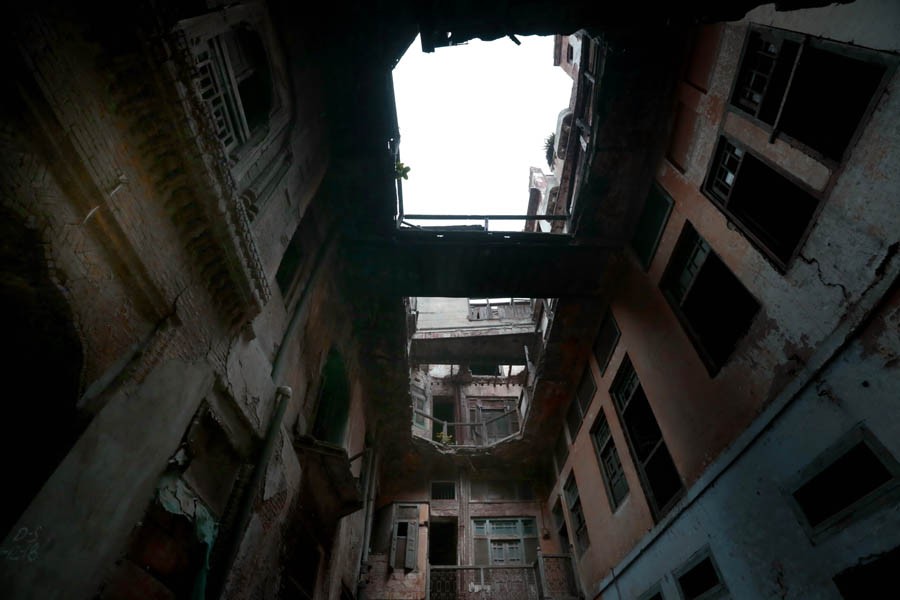
The Walled City and other neighbourhoods of Lahore are home to several buildings with dilapidated structures that are a huge life hazard

Last week, at least 15 incidents of roofs caving in, walls collapsing, and electrocution were reported, as heavy rains wreaked havoc on the city, bringing all activity in the provincial metropolis to a halt.
Since the start of the pre-monsoon season in mid June, the city has met 13 rain-related incidents which claimed four lives and injured another 21. The season has turned deadlier over the past couple of years.
Lahore’s ‘annual deluge’ -- that’s how the monsoon is being referred to these days -- uncovers the city’s ill-planned urban spread and exposes the city managers’ lack of preparedness to meet the challenges of this recurring phenomenon. As soon as the calendar turned into July, the pre-monsoon kept up its vigour with many parts of the city receiving torrential rains averaging 100mm.
The people of Lahore who have braved flash floods since 2010, can testify to how the season and its aftermath have left their deep marks. The sudden and massive scale of the deluge records scores as dead, and many who lose their homes and possessions. Rebuilding after the monsoon catastrophe is a long process that requires substantial funds.
The city planners seem not to have learnt from the past. The weather patterns have changed so that rains in urban centres now pour down in short and intense spells. Every year, the Metropolitan Corporation of Lahore announces plans to vacate residents of dilapidated buildings ahead of the monsoon season in a bid to avoid any untoward incident. Yet, every year, their plans are washed away, with the first spell of monsoon.
This year the corporation asked the respective zonal officers to share existing data on dilapidated structures before the start of the rainy season with all authorities concerned. An official notice was issued to this effect, to show the seriousness required on this matter. As a result, the zonal officers were advised to conduct a survey of all buildings situated in their designated areas and report the number of people who reside there. A stern warning was also circulated among the officers that a failure to comply with these instructions would result in disciplinary action.
As soon as the rains started, news of roofs collapsing and the residents being killed started to surface. What the town planners fail to see in these incidents is an obvious pattern: such incidents are usually reported from oldest neighbourhood of Lahore --the Walled City -- and adjoining areas. According to a survey conducted by the Walled City of Lahore Authority (WCLA), 601 properties out of a total of 22,000 properties that fall within the peripheries of the interior city are dangerous buildings, posing a threat not only to the residents of these buildings but also to the neighbourhoods they are located in. Of these, 262 properties are damaged beyond repair, and 228 need immediate attention.
The survey also reveals the numbers of dilapidated buildings to be 67 in Ward A (Taxali and Bhati Gate), 46 in Ward B (Bhati, Lohari and Pani Wala Talaab), 35 in Ward C (Lohari, Shah Almi, Pani Wala Talaab, Gumti Bazaar), 98 in Ward D (Lohari, Shah Almi, and Mori Gate), 29 in Ward E (Mochi Gate, Rang Mehal, Delhi Gate, Azam Cloth Market, Pakistan Cloth Market, Sheranwala and Masti Gate), 98 in Ward F (Akbari Gate, Chuna Mandi, Kashmiri Gate, Pakistan Cloth Market, Azam Cloth Market, Masti Gate, Rang Mehal, Sheranawala Gate), 84 in Ward G (Delhi Gate, Yakki Gate, Sheranwala Gate), 71 in Ward H (Delhi Gate, Akbari Gate), and 73 in Ward I (Rang Mehal, Mochi Gate).
Owners’ reluctance and lack of funds for repair works are key reasons behind the ever increasing numbers of ramshackle buildings. What is expected from the city managers is to come up with a similar survey of other towns and neighbourhood of Lahore, a city that is already creaking under an ever-increasing population, and has seen floods so often. The question arises whether the city managers and citizens should helplessly take urban flooding as a new normal.
Clearly, there is no evidence of a proper plan that could address the issue. Those at the helm of affairs seem to have stopped thinking about the city as a system. Their planning is myopic.
What should be done is to start by identifying rain-prone areas, create a map, and study the patterns. A serious data-gathering exercise should be taken up during monsoon to plan properly for the next deluge. Monsoon returns, and so does chaos.